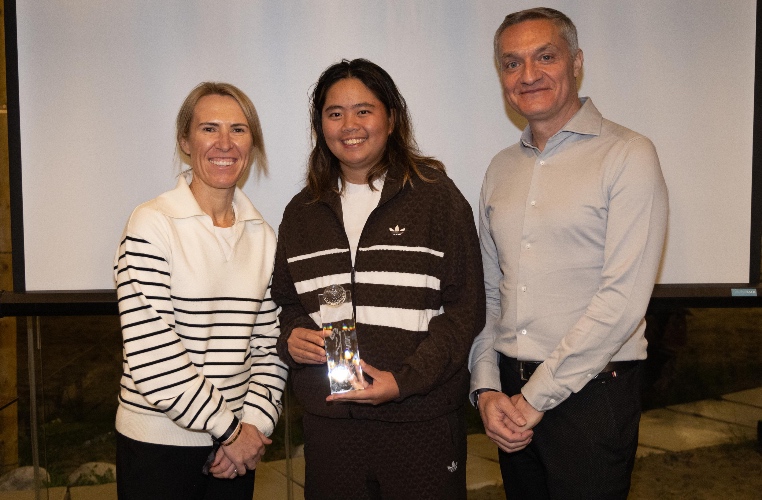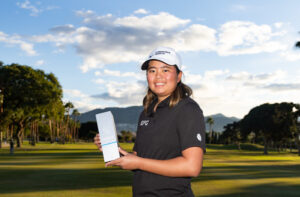 |
COLIN CALLANDER: Good morning, ladies and gentlemen, I’d like to welcome Dame Laura Davies here, winner of the 1986 Ricoh Women’s British Open here at Birkdale.
Are you used to being called Dame Laura?
DAME LAURA DAVIES: There’s been various versions from my friends but I haven’t necessarily used myself. It’s obviously an unbelievable thing to happen to a golfer, to be awarded like this, is quite extraordinary, but I don’t think you’ll ever get used to people calling you Dame.
It’s weird really in many ways, but it’s the best thing that’s ever happened in my career.
COLIN CALLANDER: How long did you know you were going to get the award?
DAME LAURA DAVIES: About five or six weeks before on the Saturday morning, in the post ‑‑ I was in the house on my own ‑‑ well, the dog was there, but he didn’t pay much interest. I rang my brother straightaway. It said in capitals “don’t tell anybody,” but in two seconds I broke that rule and my mum and stepdad came home from shopping and told them and that was it. Couldn’t telling anyone for six weeks and it was quite difficult.
COLIN CALLANDER: Do you have any vivid memories here at Birkdale.
DAME LAURA DAVIES: Yeah, ’86, I shot ‑‑ I had a thing up on my wall where the scorer writes after everybody comes in and I managed to get a copy of that.
16‑under, a five‑shot victory. I can’t remember who finished second. But at the time, it seemed easy, but I’ve not won one since. Just one of those things. It was the perfect week, I played great and beat a really strong field. There were a good few Americans over at the time. It wasn’t obviously the elevated status it is now, but even then in those days, the British Women’s Open was the big one.
Q. We understand you’re a big Liverpool fan, so we have to ask you the question, if it comes to winning the Women’s British Open again or Liverpool at long last in the League Championship, what would it be?
DAME LAURA DAVIES: Toughest question I’ve ever had. I would have to say at the moment to win the Ricoh because I’m here but ask me that question next May and I’ll say Liverpool to win the championship.
Q. In 1976 here at The Open, Seve Ballesteros burst on to the golf scene. In ’78 again here at Birkdale, Nick Faldo was at an early stage in his career, won his first four‑round championship, the Colgate PGA, and then in ’86, early start in your professional career, you won the Women’s Open. Do you think as a new member of Birkdale, that it’s reasonable to describe the course as a launchpad for a great career?
DAME LAURA DAVIES: Well, you real those names and I can check one more in Justin Rose, he was 17 when he holed that chip, I don’t know where he finished but he was high up in The Open. So there’s another career that was kind of launched at that stage.
But yeah, it’s been great for me and obviously all the other names you’ve said. It’s just a great course to come to. I was talking to you earlier. I think it’s a very fair links course. Some are not fair but this one gives you a chance to use your driver a bit. You don’t have to worry all the time about the fairway pot bunkers, although they are there and you have to maneuver yourself around some of them, so I think this has always been a very fair test.
Q. It’s been well documented that you’re the oldest player in the field this week ‑‑
DAME LAURA DAVIES: Only because Juli is not here.
Q. Because Juli is not here. So how old do you feel?
DAME LAURA DAVIES: About 21. Still feel the same. I mean, I have a bad heel at the moment so I’m walking like a 50‑year‑old, probably a 60‑year‑old. But yeah, the enthusiasm is still there. In my mind I’m good enough. I’m sure a lot of people don’t think I’m good enough, but as long as you still believe yourself you can win. If I can hole some putts and I can just sort some aspects of the game out and take the pressure off the long game, who knows.
I’ve not given up the on the chances of winning this week. I’m not saying this week and I’m not saying next week, but I’ve not given up on the chance of winning tournaments in the future. You’re as young as you want to feel basically.
Q. Juli said last month that she’s glad she’s not 20 and starting all over again and her point was how much of a job it’s become. You used to be able to turn up on Monday, and now people are showing up Sunday, practicing, grinding. With that in mind what is your take on that? Would you like to be 20, 21 and starting all over again?
DAME LAURA DAVIES: Absolutely and I’d do it exactly the same way I did it 30 years ago. I understand the pressure of these girls to get out here and practise 14 hours a week but the longevity is never going to be there. I think that’s why Juli and Lorie Kane and a few of the older players have lasted ‑‑ I know Juli does practise a lot but she does it sensibly.
Yeah, I think you can still do it the old way if you want to be successful. Look at Juli, she was one‑shot leading The Open, well, two shots, whatever it was.
But that just shows, although she might not have the fire and enthusiasm she used to have, she’s still got the game and that says something about her approach and my approach and Lorie’s approach.
Q. What’s the most you practise during a tournament week?
DAME LAURA DAVIES: I never did. It either works or it doesn’t work and that’s just my personality. I never second guess myself. If I blow a tournament with an aggressive shot, then that’s the way it was.
So I won a lot of tournaments because of that aggressive way of playing, and you could ‑‑ some people I’m sure think it’s raise I. When I’m playing badly you’ll see me on the driving range. So the less you see me on the driving range, the better you know I’m playing. And at the moment you see me on the putting green because that’s the part that’s the struggle.
You have to find your own formula. At the moment, I think because of Tiger, everybody who comes out has nutritionalists and coaches and mind coaches and that’s just modern golf and that’s just the way it is for these girls. I seriously doubt whether they will be playing into their 40s and certainly 50s.
Q. Is it down to peer pressure that most of them feel they ought to be out on the range all the time?
DAME LAURA DAVIES: I don’t know. Just feels like sometimes it seems like they are practicing because they think they should practise and maybe that’s the way it is.
I mean, perhaps that’s the way forward but certainly for my generation and Juli’s generation, there’s a lot of practise but there’s a lot of fun, as well. Possibly not quite as much fun as it used to be but I’m sure they are enjoying it. They play unbelievable golf.
Doesn’t matter who you are paired with on Tour anymore. They are all really good players, great putters and it’s fun to see. I must admit I’m glad I’m still playing because it’s fun to see the Lexi Thompsons hit now and Michelle Wie and she’s back on top of the world basically. I think she’s fulfilling her potential and it’s great to see that.
Q. How did you do your heel?
DAME LAURA DAVIES: Just walking, isn’t it. I can’t even pronounce it, it’s really painful, that’s all I know.
Q. Not a straightforward footballing injury?
DAME LAURA DAVIES: No, that was the Achilles a couple of years ago at the Evian. That was my last injury. This one is just wear and tear.
Q. You said that you don’t think players will be going into their 40s and 50s?
DAME LAURA DAVIES: I don’t really know what burnout means but I just think they will be fed up with it because when you spend every week, even when they have a week off, you can understand, they are all practising and playing.
I think eventually it becomes a job and it’s never been a job for me. It’s always been great fun, really one of the luckiest people in the world to play a game that I love, and obviously been fortunate enough to win a lot of events.
But that’s always been the side of it. It’s never been, oh, I’ve got to go and practise now, I have to go and do this. It’s always been, I want to go and practise, I want to go and do this. I think possibly that’s why the careers are going to become a bit shorter. It’s great, because while they are all playing, they are playing so well; why wouldn’t you do it. If you’re achieving those heights so young and early, why not go for it. Hopefully Michelle Wie will be playing when she’s 50 and that will be great for the game.
Q. As well as you know this course, if you could speak to the conditions and the thickness of it and how that adds to the difficulties.
DAME LAURA DAVIES: Well, I just said I think it’s one of the fairest courses. The bunkering can be a problem. Like I said, if you pick the wrong line, you’re just going to have to lob it out and take your bogey.
But the fairways are wide enough where you can’t complain if you get a horrible lie in the rough because if you go in the long stuff, there will be lots of marshals out there, it will be hard to even find the balls. Yesterday in the Pro‑Am people were missing fairways by a couple of feet and we couldn’t find the ball.
Yeah, hit it straight, you don’t really have to hit it massively long but keep it in play and you’ve got a low number out there. The greens, the edges of the greens, the chipping areas, are just flawless. I think the scoring could be good but there are going to be some big numbers imagine.
There will be a lot of 2‑irons out there, a few drivers and obviously the par 5s are all reachable which is great. 17 and 18 usually go downwind which is going to give on Sunday hopefully a massive finish, because you can have big seven‑shot swings on those holes. Yeah, it’s going to be great. My golf membership’s here now so I can dig the course up.
Q. Can you elaborate on what exactly you’re working on in your putting stroke? Is it technical or more visualization on the greens?
DAME LAURA DAVIES: On the putting green, and they had some computer stuff out there yesterday and we worked out that my alignment was wrong. He said line up to the centre of the hole, it was a dead‑straight putt and I was four degree off. I just made a little adjustment in my grip and I managed to get that on average a lot less than I was.
So hopefully the putts that I’ve been missing just on the edges the last couple of years has been because my alignment’s been wrong. Only time will tell but it’s something to work on. I think pace is my biggest problem. I don’t know if you lose your feel as you get older possibly, I don’t know.
But that’s something we are working on and hopefully we will start seeing the results because it really is holding me back. It’s so frustrating, Saturday and Sunday last week down in Buckinghamshire, I had 37 and 38 putts which is giving 15, 20 shots away on the weekend which is ludicrous. I think I had seven 3‑putts. Yeah, it’s a real problem but it’s my problem to solve.
Q. What do you remember about your first 1980 Open and what is a highlight that you can recall?
DAME LAURA DAVIES: Well, obviously the win in ’86 has to be the highlight because it’s the only time I got the trophy. But 1980, I was a 17‑year‑old, or I would have been 19 and an amateur, and I can’t remember, we stayed in a house somewhere, Mum and stepdad and brother was up here, probably caddying for me.
I do remember Marta winning it and I have no idea where I finished. I think I made the cut ‑‑ oh, I missed the cut. I’m rubbish. There you go. I shot 72‑88, and have absolutely no recollection of the week at all. (Laughter).
Q. What brought you the greatest joy in golf when you were in your 20s and what annoyed you in your 20s about the game and now is there a change?
DAME LAURA DAVIES: The only thing that’s ever really annoyed me about golf is internal out‑of‑bounds. I never understand it because the course designer doesn’t do a good enough job where you can cut a corner so they stake a white stake in and that’s something that’s really irritated me, and the joy of trying to win, it’s the same at 20 as it is now.
I feel like if I put it together I can have a chance this week and that for me is the best part of being a professional golfer. Obviously it might not happen but at least if you bounce up onto that first tee Thursday morning really nervous, which is a sign that you fancy your chances ‑‑ you know it’s not over and I’ve still got that fun side of it.
Q. Have you ever not cared?
DAME LAURA DAVIES: The lowest point probably was about seven or eight years ago at Nabisco when I was playing so badly when I actually thought, I can’t do it anymore and I that the 84 in the second round, missed the cut by a mile and flew home not very happy, probably the worst I ever felt, but two weeks later there I was.
Q. Lastly when you mentioned the internal stakes, do you have an opinion on the caddie ‑‑
DAME LAURA DAVIES: It shouldn’t be allowed. It’s a basic part of any golf, alignment. You’re not allowed to get a grip that’s perfectly set for you and just wedge your hands into a molded grip, so why should you have someone allowed to stand behind you and tell you where to aim? I don’t understand the USGA and the R&A haven’t sussed that one out yet because it just seems basic. And it slows the game down.
Q. While you’re in that mode, what other rules do you not approve of?
DAME LAURA DAVIES: Making me putt out when I’ve made a bad putt ‑‑ (laughter), 2‑putt maximum.
COLIN CALLANDER: Dame Laura, thank you very much for your time and hope the putts drop this week.



















